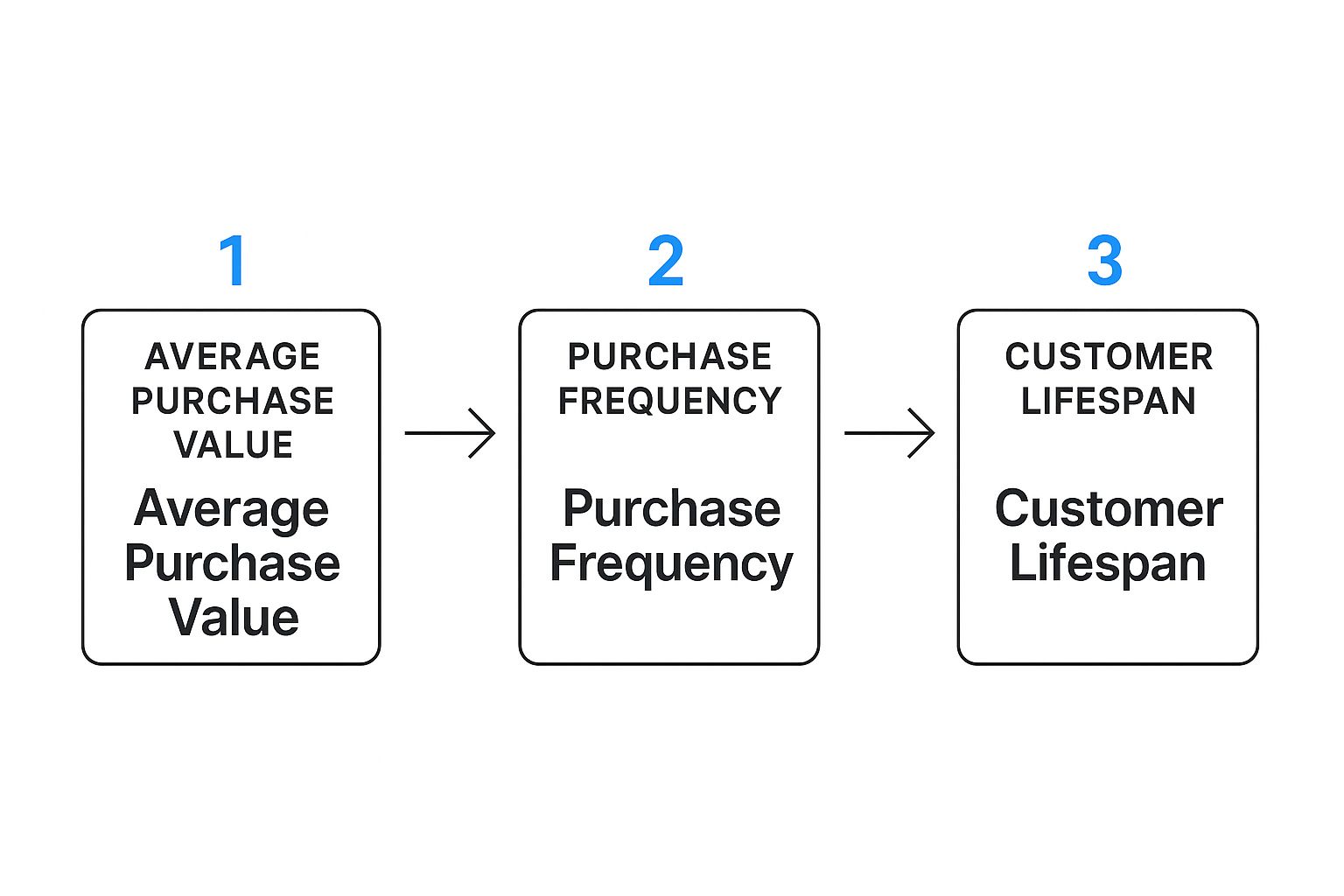To figure out your Customer Lifetime Value (CLTV), the basic idea is to multiply a customer's average purchase value by how often they buy, and then by how long they stick around. This simple formula gives you a surprisingly powerful estimate of the total profit you can expect from a single customer. It's the key to understanding who your best customers are and focusing your efforts where they'll count the most.

Customer Lifetime Value, or CLTV, is a prediction of the total profit your business will make from a customer over their entire relationship with your brand. Think of it less as a metric and more as a fundamental shift in perspective. Instead of zeroing in on single transactions, CLTV forces you to think about the long game: building sustainable customer relationships that fuel real growth.
Knowing this number empowers you to make smarter, data-driven decisions across your entire business. A solid grasp of CLTV is essential for:
Before diving into complex predictive models, the traditional CLTV formula offers a fantastic starting point. It’s straightforward and gives you a solid baseline to work from.
The historic formula is: (Average Monthly Transactions × Average Order Value × Gross Margin × Average Customer Lifespan).
Let's run a quick example. Say a customer averages 2 transactions per month at $50 each, with a 20% gross margin. You expect them to stay with you for 24 months.
Their CLTV would be: (2 × $50 × 0.20 × 24) = $480.
While this model doesn't factor in things like churn or discount rates, its simplicity makes it incredibly accessible for an initial analysis. It helps you gauge marketing effectiveness and builds a foundation for more advanced predictive modeling down the road.
This metric transforms how you view your customers. It’s not about their last purchase; it's about their entire potential journey with you. This insight is what separates businesses that grow consistently from those that don't.
By calculating CLTV, you're not just running numbers—you're uncovering the true engine of your business's profitability. To get a handle on all the moving parts, you need to know what data to pull.
To get started, you'll need to gather a few key pieces of data. These metrics form the backbone of any CLTV calculation, whether you're using a simple formula or a more complex model.
Having these numbers ready will make the calculation process smooth and accurate.
As you can see, calculating CLTV forces you to look at your business through a more strategic lens. If you're ready to explore this further, you might be interested in our complete guide to customer lifetime value.
A formula is only as good as the numbers you plug into it. Before you can even think about calculating Customer Lifetime Value (CLTV), you have to do the prep work. Getting this part right is crucial, because a trustworthy CLTV depends entirely on clean, reliable data.
The good news? You probably already have all the information you need. It’s sitting right there in your CRM, e-commerce platform, or accounting software. You just need to know where to look and how to pull it all together.
The goal here is to source accurate data for each piece of the CLTV formula. If your inputs are off, your final calculation will be misleading, and that can steer your entire strategy in the wrong direction.
Here’s where I usually find what I need:
The metric that often trips people up is the Average Customer Lifespan. This requires getting a handle on your customer churn rate—the percentage of customers who stop doing business with you over a set period.
For subscription-based businesses, this is actually pretty straightforward. You can calculate the Average Customer Lifespan by dividing 1 by your churn rate. For example, if you have a monthly churn rate of 5% (or 0.05), your average customer lifespan is 20 months (1 / 0.05). It's a simple formula that gives you a solid estimate of how long you can expect to keep a customer. For more tips on this, sixads.net has a great breakdown of CLTV metrics.
Pulling this data together not only builds your CLTV but also sheds light on other critical metrics. For instance, the real power comes when you compare your CLTV to your Customer Acquisition Cost (CAC). To get a better handle on that, check out our guide on the average CAC for B2B SaaS companies.

When it comes to calculating CLTV, there isn't a one-size-fits-all formula. The right model for your business really depends on your stage of growth and the data you actually have on hand. It boils down to two main approaches: Historic and Predictive CLTV.
I like to think of it like driving. The historic model is your rearview mirror—it shows you exactly where you've been. The predictive model is your GPS—it maps out the road ahead.
The historic approach is the simplest and most direct. It’s all about looking at past data to see what a customer has already spent. You’re just adding up the total profit from their past purchases. This method is perfect for newer businesses or anyone just dipping their toes into CLTV because it's easy to calculate and gives you a solid, factual baseline to start from.
Key Takeaway: Historic CLTV is grounded in facts, telling you exactly what a customer was worth up to this point. It's a great starting point, but it works on the assumption that the future will mirror the past—and we all know that's rarely the case.
Let's say a customer made three purchases with you, totaling $450. If your business operates on a 30% gross margin, their historic CLTV is a straightforward $135 ($450 x 0.30). It's that simple because you're only using transaction data you already have in your system. You can get a more detailed look at this by reading about historical CLTV on OWOX.com.
Now, for the GPS. Predictive CLTV is your forward-looking model. It digs into historical data, yes, but it also layers in behavioral patterns and statistical models to forecast a customer's future value. This is where things get really powerful, especially for established businesses sitting on a good chunk of customer data.
So, who benefits most from this?
Predictive models are definitely more complex. You might need specialized analytics software or someone on your team with data science chops to get them set up. But the payoff is a far more accurate and actionable number. It helps you understand not just what a customer was worth, but what they could be worth down the road.
This kind of insight is also critical for accurately assigning value to your marketing channels. When you know which customers are likely to become your most valuable, you can fine-tune your retention strategy and acquisition budget with a whole new level of confidence. To explore this further, check out our guide on how to measure marketing attribution.
Alright, let's move past the theory and get our hands dirty. There’s no better way to really get how to calculate CLTV than by running the numbers with a real-world example. So, let’s pretend you run an online coffee subscription service.
First things first, you need to pull some core metrics from your sales and analytics platforms. Here’s what we’ll work with:
This simple infographic breaks down how these key metrics flow into each other to give you that final CLTV number.

As you can see, each piece of the puzzle builds on the last. Now, we'll use a straightforward predictive formula that’s especially good for subscription models like our coffee service. The simple formula for Customer Lifetime Value is (Customer Value / Churn Rate).
To get the Customer Value, you just multiply the average purchase value by the purchase frequency. With a $30 average order and one purchase a month, our customer value is $30. For a deeper dive into different calculation models, you can discover more insights about CLTV formulas on clevertap.com.
With our customer value of $30 and a churn rate of 10% (or 0.10), the math is pretty simple:
CLTV = $30 / 0.10 = $300
What this tells you is that, on average, you can expect each subscriber to bring in $300 in revenue over their entire time with your brand.
But this is where CLTV becomes incredibly powerful. What if you rolled out a new loyalty program that cut your monthly churn from 10% down to just 8%?
Let’s run the numbers again with that improved churn rate:
New CLTV = $30 / 0.08 = $375
That tiny 2% drop in monthly churn just boosted your CLTV by $75—a 25% jump. This is the perfect demonstration of how even small improvements in customer retention can have a massive impact on your long-term profitability. This tangible result is exactly why CLTV is so much more than a vanity metric; it’s a critical guide for making smart business decisions.

Alright, you've done the math and calculated your Customer Lifetime Value. What now? This is where the real work—and the real fun—begins. Thinking of CLTV as just another number on a dashboard is a huge mistake. It’s actually a strategic compass that can guide almost every major decision you make, steering your business toward sustainable, long-term growth.
With a solid CLTV figure in hand, you can start slicing and dicing your customer base in incredibly powerful ways. You can finally pinpoint your high-value cohorts—those dream customers who spend more, stick around longer, and are genuinely loyal to your brand. These are your VIPs, and you should be treating them like it with exclusive offers, early access to new features, or personalized outreach.
On the flip side, you can identify your low-value segments and build targeted campaigns to nurture them, turning them into more profitable, long-term partners. For a deeper dive, our guide on maximizing LTV for SaaS growth is packed with actionable strategies.
One of the most powerful ways I've seen CLTV used is by stacking it up against the Customer Acquisition Cost (CAC). This simple ratio is the ultimate health check for your business model. It tells you, in no uncertain terms, whether you're building a profitable machine or just spinning your wheels.
The gold standard, the number everyone shoots for, is a CLTV-to-CAC ratio of 3:1. In plain English, this means that for every $1 you spend to bring a new customer in the door, you're getting $3 back over their lifetime. It’s the sweet spot.
This isn't just an academic exercise; it's what gives you the confidence to approve marketing budgets and fine-tune your ad spend. A high ratio, maybe 5:1, is a bright green light to pour more fuel on the fire and scale aggressively. But a low ratio, like 1:1, is a massive red flag. It’s a signal to hit the brakes and figure out how to either reduce your acquisition costs or, more likely, improve your customer retention.
For businesses with long customer lifecycles—think SaaS or subscription models—it’s smart to get even more granular. Predictive CLTV models often bring in a discount rate, usually somewhere between 10% and 15%. This accounts for the time value of money, adjusting future revenue to its value today. It’s a more sober, realistic way to forecast your finances and is a must for any serious financial planning.
Even after you've run the numbers, a few common questions always seem to pop up when teams first start digging into CLTV. Let's tackle some of the most frequent sticking points to clear up any lingering confusion.
I usually tell people that a quarterly calculation is a great place to start. This gives you enough time to spot real shifts in customer behavior, seasonality, or the impact of your latest marketing campaigns without turning it into a huge administrative chore.
Now, if your business is in a serious growth spurt or you're actively testing a bunch of new strategies, you might want to bump that up to a monthly calculation. The more immediate feedback can be incredibly valuable in those situations.
Remember, CLTV isn't a "set it and forget it" metric. It's a living number that should evolve with your business, reflecting your efforts to improve the customer experience.
Absolutely, you just have to approach it a bit differently. When you don't have years of historical data to lean on, you can't calculate a long-term average customer lifespan. It’s just not there yet.
Instead, new businesses often look at industry benchmarks for churn or make some conservative estimates for their first year. Even a projection based on limited data is so much better than flying blind. It gives you a baseline that you can refine as more data comes in.
For a new business, the best move is to focus on what you can control right now: increasing average order value and nailing your early retention. You can also explore proven customer retention strategies for SaaS companies to build a strong foundation from day one. Getting that right will directly boost your future CLTV.
Learn how Cometly can help you pinpoint channels driving revenue.
.svg)
Network with the top performance marketers in the industry